Paintings : 166
-
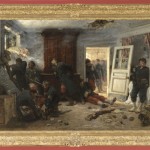 PaintingThe Last Cartridges
PaintingThe Last CartridgesThis painting by Alphonse de Neuville (He was born ‘Deneuville’ and changed his name to ‘de Neuville’ later on)(1835-1885) was revealed to the public in 1873 and became famous overnight. Originally from Saint-Omer, Neuville was a pupil at the École des Mousses de Lorient for a brief spell in his youth before going on to study […]
-
![Portrait of Otto von Bismarck in 1870 [Photograph]](https://www.napoleon.org/wp-content/thumbnails/uploads/2020/03/450photo_bismarck1870-tt-width-150-height-150-crop-1-bgcolor-ffffff-lazyload-0.jpg) PaintingPortrait of Otto von Bismarck in 1870 [Photograph]
PaintingPortrait of Otto von Bismarck in 1870 [Photograph]When the Franco-Prussian War broke out in 1870, Otto von Bismarck (1815-1898) was at the head of the Prussian state and had been King Wilhelm’s direct right-hand man for over seven years. He had been recalled from his post as ambassador to France in September 1862 to take up the position of Minister President of the Kingdom […]
-
![La Ménagerie impériale, composée des ruminants, amphibies, carnivores et autres budgétivores qui ont dévoré la France pendant 20 ans [the Imperial Menagerie, featuring ruminants, amphibians, carnivores, and other state-funding-ivores who have been devouring France for the last 20 years]](https://www.napoleon.org/wp-content/thumbnails/uploads/2020/02/900menagerie-couv-tt-width-150-height-150-crop-1-bgcolor-ffffff-lazyload-0.jpg) PaintingLa Ménagerie impériale, composée des ruminants, amphibies, carnivores et autres budgétivores qui ont dévoré la France pendant 20 ans [the Imperial Menagerie, featuring ruminants, amphibians, carnivores, and other state-funding-ivores who have been devouring France for the last 20 years]
PaintingLa Ménagerie impériale, composée des ruminants, amphibies, carnivores et autres budgétivores qui ont dévoré la France pendant 20 ans [the Imperial Menagerie, featuring ruminants, amphibians, carnivores, and other state-funding-ivores who have been devouring France for the last 20 years]The Second Empire, it is true, was built upon the idea of the First, but the liberalisation of the Second (from 1861 on) was not a step that the uncle ever took; at least not until the extraordinary Hundred Days, and even then only half-heartedly. As a result, the political caricatures that assailed Napoleon I […]
-
![Orsini’s attack [on Napoleon III] outside the Opera, 14 January 1858](https://www.napoleon.org/wp-content/thumbnails/uploads/2020/01/attentat_orsini-tt-width-150-height-150-crop-1-bgcolor-ffffff-lazyload-0.jpg) PaintingOrsini’s attack [on Napoleon III] outside the Opera, 14 January 1858
PaintingOrsini’s attack [on Napoleon III] outside the Opera, 14 January 1858This painting depicts the attack carried out by the Italian revolutionary Felice Orsini against Napoleon III, and is the work of the little-known Italian painter H. Vittori. It is signed and dated “H. Vittori Romano 1862”. In the top left-hand quarter of the painting we can see part of the façade of Paris Opera which […]
-
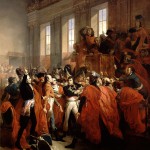 Painting“General Bonaparte in the Council of the Five Hundred, at Saint-Cloud, 10 November 1799”
Painting“General Bonaparte in the Council of the Five Hundred, at Saint-Cloud, 10 November 1799”This oil-on-canvas painting by François Bouchot (1800-1842) was executed in 1840 as a result of a commission in 1838 by King Louis-Philippe. The latter was attempting to harness in his favour a contemporary wave of nostalgia for Napoleon, in the wake of his dedication of the château de Versailles to all the glories of France. The painting […]
-
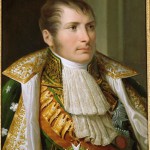 PaintingPortrait of Eugène de Beauharnais
PaintingPortrait of Eugène de BeauharnaisThis oil on canvas portrait of Prince Eugène de Beauharnais, Viceroy of Italy was executed in 1810 by Andrea Appiani (1754-1817), the so-called “Painter of Graces” and also First Painter for the King of Italy, Napoleon I. Appiani painted many portraits and palace frescoes for the family of the Emperor and King, many of which, alas, disappeared […]
-
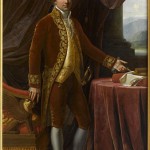 PaintingPosthumous portrait of Charles Bonaparte
PaintingPosthumous portrait of Charles BonaparteThis posthumous portrait of Charles Bonaparte is by Anne-Louis Girodet de Roussy-Trioson – more commonly known as Girodet. The artist painted two versions, the first in 1805 (presented in this article) and another version in 1806 (which can be seen here). The two – almost identical – paintings are now held, respectively, at the Château de […]
-
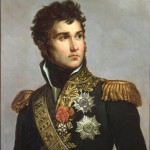 PaintingPortrait of Marshal Lannes
PaintingPortrait of Marshal LannesThis portrait of Jean Lannes (1769-1809), today held at the Musée de l’Armée in Paris, was painted in 1834 by Julie-Louise Volpelière. It was commissioned from the painter for the future Musée d’Histoire de France de Versailles, a project of King Louis-Philippe’s. In this work, Volpelière was in fact copying a portrait made by Baron […]
-
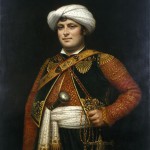 PaintingPortrait of Raza Roustam, Mamluk and Napoleon’s bodyguard
PaintingPortrait of Raza Roustam, Mamluk and Napoleon’s bodyguardThis portrait, attributed to Jacques Nicolas Paillot de Montabert and which remained in Raza Roustam’s possession until his death, was probably commissioned by Roustam himself at the time of his marriage. The painting then went to his son-in-law, who left it to Pierre-Albert Beaufeu, the executor of his will. Beaufeu gave it to the Musée de […]
-
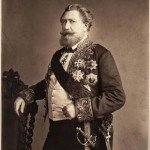 PaintingA photographic portrait of Comte Émilien de Nieuwerkerke (1811-1892), intendant des Beaux-Arts (1853), honorary chamberlain of the Emperor (1859)
PaintingA photographic portrait of Comte Émilien de Nieuwerkerke (1811-1892), intendant des Beaux-Arts (1853), honorary chamberlain of the Emperor (1859)It was the job of photographer Léon Crémière (1831-1913) to photograph the members of the “Maison de l’Empereur” [the Emperor’s Household], and the shot here is his magnificent portrait (1861) of Émilien de Nieuwerkerke, an essential figure in the artistic life of the Second Empire, who at the time had been intendant des Beaux-Arts since […]

